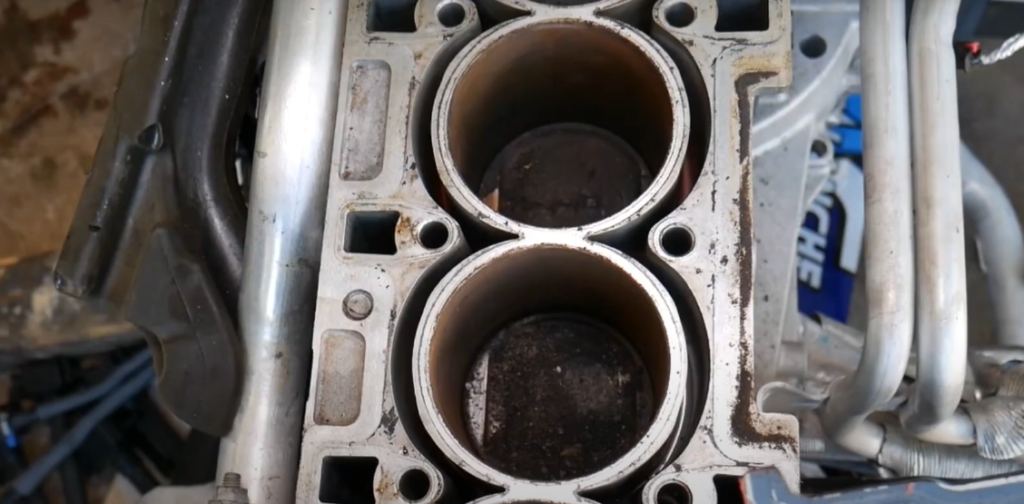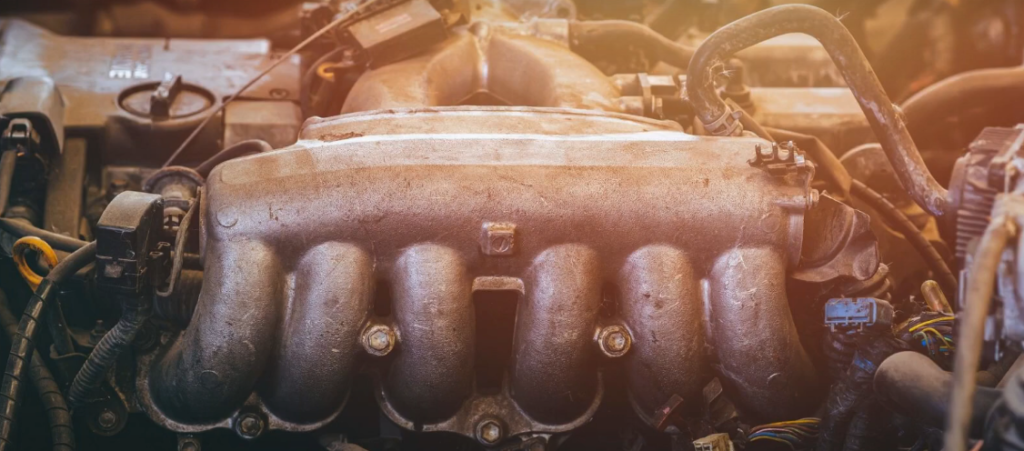Exhaust manifold overheating occurs when the manifold is exposed to excessive heat, often due to a lean air-fuel mixture, exhaust restrictions, or improper engine timing. Symptoms include a glowing red manifold, engine misfires, and burning smells. Overheating can lead to cracks, warping, or damage to surrounding components.
The exhaust manifold plays a critical role in the engine’s exhaust system, as it collects exhaust gases from the engine’s cylinders and directs them into the exhaust system. However, like many engine components, the exhaust manifold is subjected to intense heat and pressure. Over time, this can lead to overheating, which can cause significant engine problems and potentially expensive repairs.
Contents
Causes of Exhaust Manifold Overheating?
Several factors can contribute to the exhaust manifold overheating. Understanding these causes can help you diagnose the problem and take preventative measures to avoid further damage.
1. Lean Air-Fuel Mixture
A lean air-fuel mixture occurs when there is too much air and not enough fuel in the combustion chamber. This imbalance causes the engine to run hotter than normal, which puts additional stress on the exhaust manifold. Over time, the excessive heat can cause the manifold to overheat, warp, or even crack. A lean condition can be caused by problems such as a malfunctioning fuel injector, vacuum leaks, or faulty oxygen sensors.
2. Exhaust Restrictions
Any restriction in the exhaust system can cause a buildup of heat. This can occur due to a clogged catalytic converter, a damaged muffler, or excessive carbon buildup in the exhaust pipes. When the exhaust gases cannot flow freely through the system, the heat can back up into the manifold, causing it to overheat. Clogged components also increase back pressure, making the engine work harder and generate more heat.
3. Excessive Engine Load
Running your engine at high loads for prolonged periods, such as when towing heavy loads, driving at high speeds, or climbing steep inclines, can cause the engine to generate excessive heat. This increased load results in higher exhaust gas temperatures (EGTs), which can overheat the exhaust manifold. If the manifold is not designed to handle such temperatures or is already compromised, it can warp, crack, or degrade over time.
4. Exhaust Leaks
Exhaust manifold leaks can contribute to overheating by allowing hot gases to escape into the engine bay, where they may heat up surrounding components, including the manifold itself. This can cause localized overheating, warping the manifold, and increasing the risk of damage to other engine components. In addition to overheating, exhaust leaks can also reduce engine efficiency and increase emissions.
5. Improper Timing or Engine Tuning
If the engine’s timing is off, such as in cases of ignition timing that is too advanced or retarded, it can cause the exhaust manifold to overheat. Incorrect timing alters the combustion process, which can lead to abnormal combustion temperatures. Similarly, engines that are improperly tuned, especially for high-performance applications, may run hotter than usual and cause the manifold to overheat.
Symptoms of Overheating Exhaust Manifold
Identifying the symptoms of an overheating exhaust manifold is crucial for early diagnosis and preventing further damage. Here are some common signs:
1. Glowing Exhaust Manifold
One of the most visible signs of an overheating manifold is when it begins to glow red or orange. This usually occurs when the manifold reaches excessively high temperatures, typically over 1,200°F (650°C). A glowing manifold is a clear indication that something is wrong and needs immediate attention.
2. Engine Misfires
Overheating can cause exhaust manifold leaks or cracks, which can lead to engine misfires. When the manifold is damaged, it may allow unburned fuel and air to escape before reaching the catalytic converter, disrupting the engine’s combustion process. Misfires are often accompanied by rough idling, reduced engine performance, and decreased fuel efficiency.
3. Burning Smell
If the exhaust manifold becomes excessively hot, it can cause nearby components, such as wires, hoses, or plastic parts, to melt or burn. This may produce a strong burning smell that is noticeable from inside the cabin or around the engine bay. Ignoring this symptom can lead to further damage and possibly engine fires.
4. Increased Engine Temperature
An overheating exhaust manifold can cause the entire engine to overheat, leading to rising coolant temperatures. If the engine cooling system is unable to manage the additional heat, the engine may begin to overheat, which can result in serious engine damage, including a blown head gasket or warped cylinder head.
5. Unusual Noises
Exhaust leaks caused by manifold cracks or gasket failures can cause hissing or ticking noises, especially when the engine is under load or accelerating. This noise is often more noticeable when the engine is cold, as the cracks may expand as the manifold heats up.

How to Prevent Exhaust Manifold Overheating
Preventing exhaust manifold overheating requires regular maintenance and attention to any underlying issues. Below are some tips to help reduce the risk:
1. Maintain Proper Air-Fuel Ratio: One of the most important aspects of preventing exhaust manifold overheating is ensuring that the engine maintains the correct air-fuel ratio. This can be done by keeping your fuel injectors, oxygen sensors, and air intake system in good working condition. Regularly inspecting and cleaning these components can prevent lean conditions that lead to overheating.
2. Address Exhaust Restrictions: A clogged catalytic converter or muffler can cause back pressure that leads to overheating. Regularly inspect and replace these components if they show signs of damage or excessive wear. If your vehicle has high mileage, consider having the exhaust system cleaned to remove any carbon buildup.
3. Monitor Engine Timing: Ensure that your vehicle’s ignition timing is properly set according to the manufacturer’s specifications. Faulty timing can lead to abnormal combustion temperatures and increased heat production in the exhaust manifold. If you suspect timing issues, consult a mechanic or use diagnostic tools to assess the engine’s timing.
4. Use Heat Shields: Many vehicles are equipped with heat shields to protect nearby components from excessive exhaust heat. If your vehicle’s heat shields are damaged or missing, replace them immediately to prevent overheating in the exhaust manifold and other engine components.
5. Avoid Prolonged High Engine Loads: While it may not always be possible to avoid high engine loads, especially when towing or climbing steep hills, try to minimize sustained periods of heavy load. Allow your engine to cool down by reducing speed or taking breaks during long drives.
Repairing an Overheating Exhaust Manifold
If your exhaust manifold has overheated and sustained damage, such as cracks or warping, it may need to be repaired or replaced. Here’s a basic overview of the repair process:
1. Inspect the Manifold: A mechanic will begin by inspecting the manifold for visible cracks, warping, or other signs of damage. They will also check for exhaust leaks, which could be contributing to the overheating issue.
2. Repairing Minor Cracks: In some cases, small cracks in the exhaust manifold can be repaired by welding. However, this is typically a temporary fix, and the manifold may eventually need to be replaced.
3. Replacing the Manifold: If the manifold is severely damaged or warped, it will need to be replaced. A new exhaust manifold can range in price from $150 to $700, depending on the make and model of your vehicle. Labor costs will vary depending on the complexity of the repair, but can range from $100 to $300.
4. Replacing Gaskets: If the overheating has caused the manifold gasket to fail, the gasket will need to be replaced. Exhaust manifold gaskets are relatively inexpensive, typically costing between $20 and $60.

Frequently Asked Questions
Here are some FAQs about exhaust manifold overheating –
1. What causes an exhaust manifold to overheat?
Exhaust manifold overheating is often caused by a lean air-fuel mixture, exhaust restrictions, excessive engine load, or exhaust leaks. Improper engine timing can also contribute to overheating.
2. How hot does an exhaust manifold get?
An exhaust manifold can reach temperatures of 500°F to 1,200°F under normal driving conditions. However, under high-performance or heavy-load conditions, the manifold can exceed 1,600°F.
3. Can a glowing exhaust manifold damage the engine?
Yes, a glowing exhaust manifold indicates extreme overheating, which can cause damage to the manifold itself and other engine components. If you notice a glowing manifold, it’s important to address the issue immediately.
4. How can I prevent my exhaust manifold from overheating?
To prevent exhaust manifold overheating, maintain the proper air-fuel ratio, address exhaust restrictions, ensure correct engine timing, and use heat shields. Regular maintenance and inspections are key to preventing overheating.
5. Can I drive with an overheating exhaust manifold?
Driving with an overheating exhaust manifold is not recommended. Overheating can lead to engine damage, reduced performance, and potential safety hazards. It’s important to diagnose and repair the issue as soon as possible.
Conclusion
Exhaust manifold overheating is a serious issue that can lead to engine damage if not addressed promptly. Causes like a lean air-fuel mixture, exhaust restrictions, or improper timing can all contribute to overheating. Recognizing the symptoms, such as a glowing manifold, engine misfires, and burning smells, is crucial for early diagnosis and repair. Preventative maintenance, such as maintaining proper air-fuel ratios and addressing exhaust restrictions, can help avoid overheating and prolong the life of your exhaust manifold.